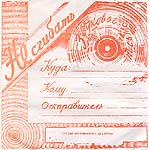| Introduction 1900-1940 Boom of 78 rpm Local Industry Long Playing Special Issues "Sounding Letters" Envelopes Listen Records Guestbook Radio Museum |
|
| Introduction 1900-1940 Boom of 78 rpm Local Industry Long Playing Special Issues "Sounding Letters" Envelopes Listen Records Guestbook Radio Museum |
|
 |
Into such special postal envelopes sounding letters of the records studio of the town of Tskhaltubo (Georgia) were enclosed. |
 |
Shown here laminated black-and-white card with a sound track was recorded in Odessa at Records Studio No.1 of "Odesfoto" factory in early 1960s. Its dimensions are 200 x 145 mm. |